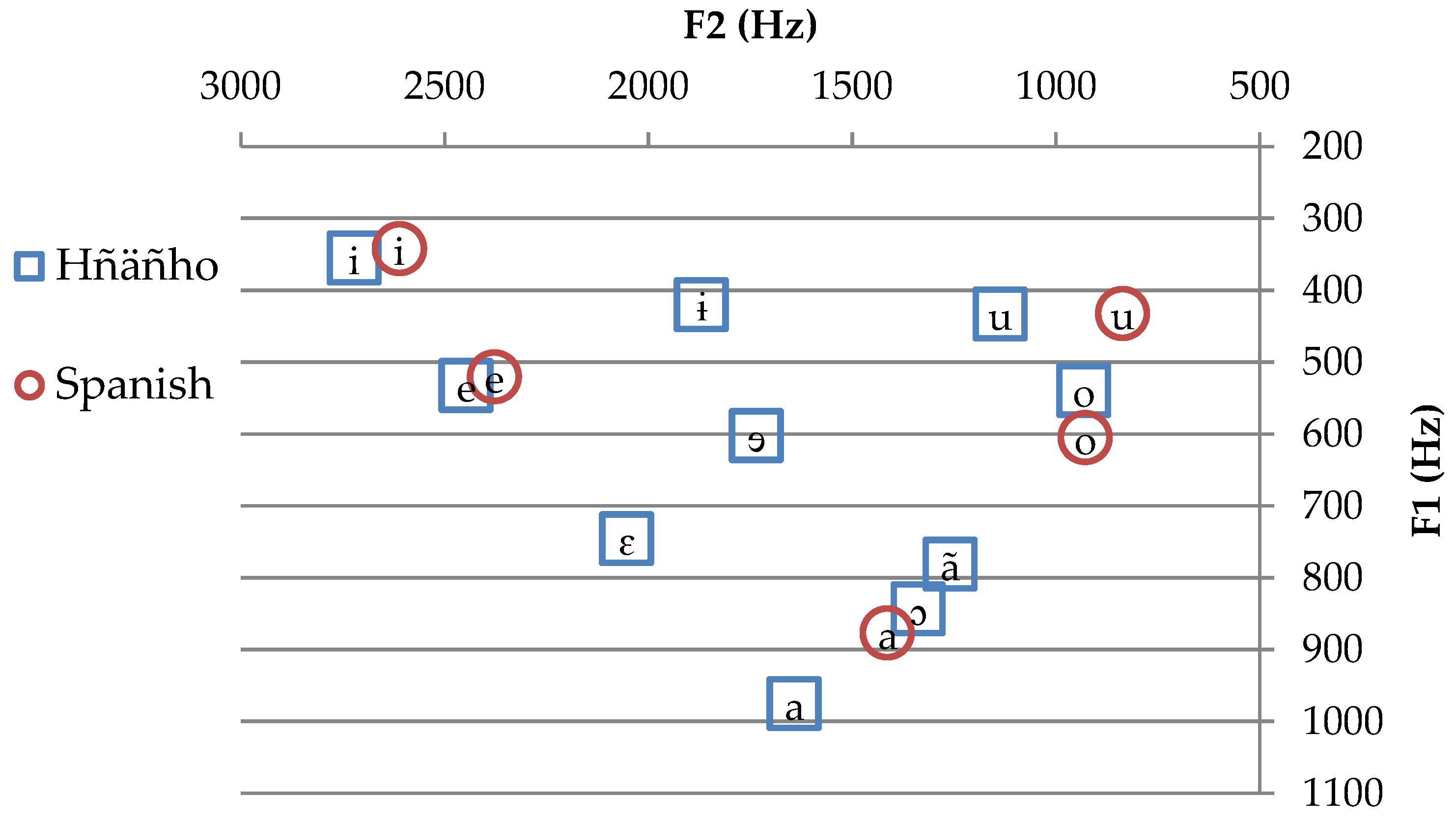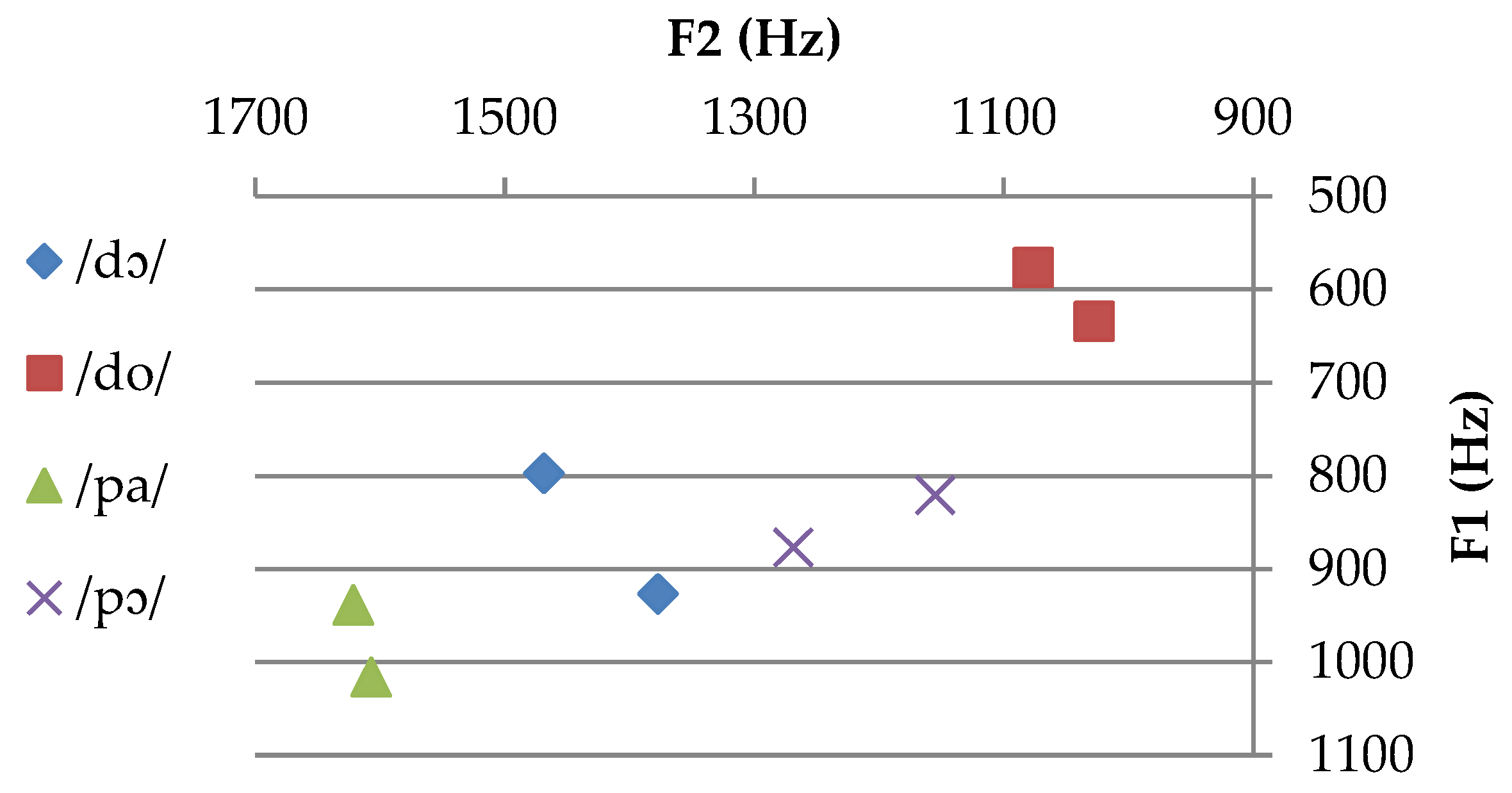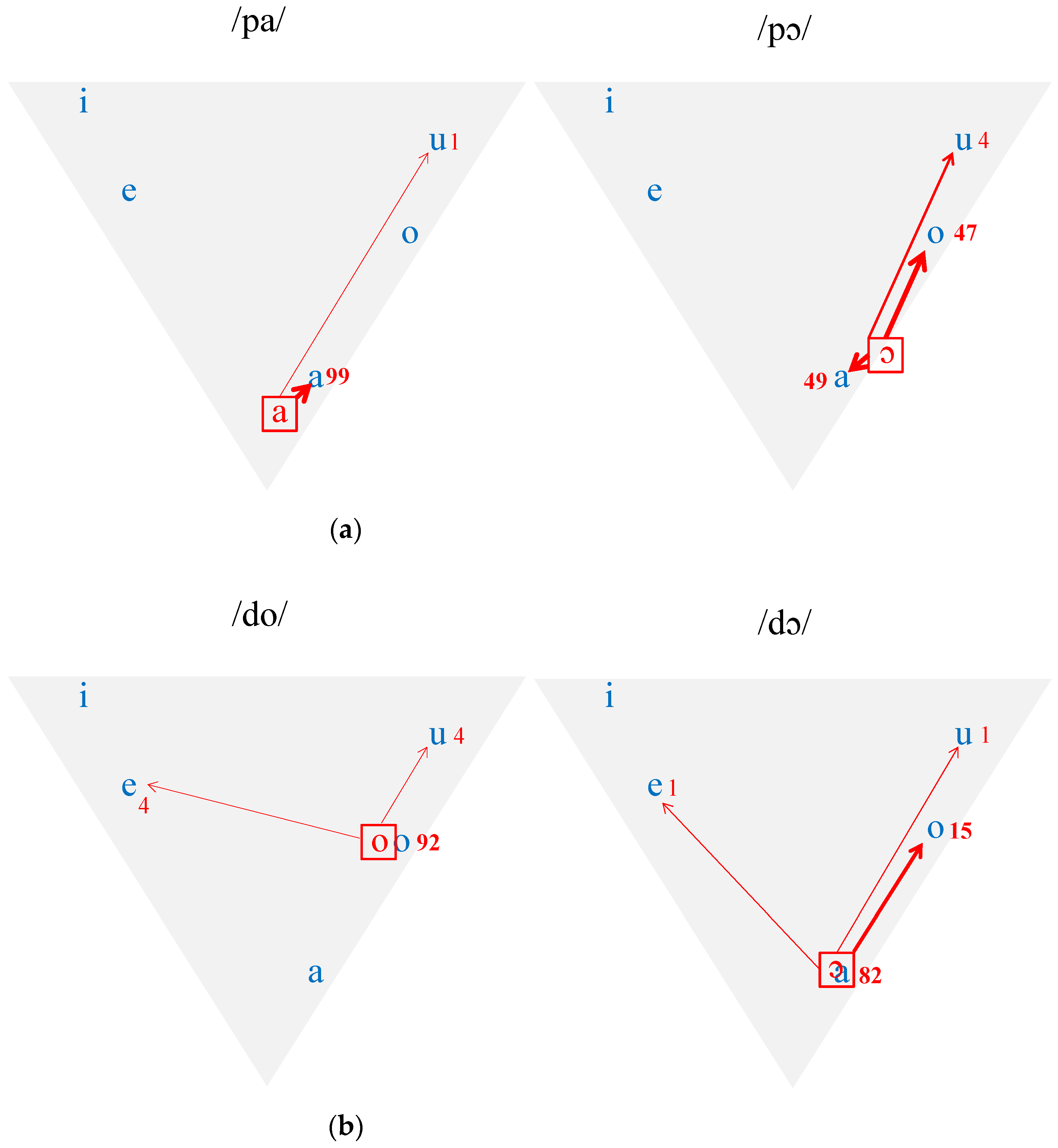Perceptual Categorization of Hñäñho-Specific Vowel Contrasts by Hñäñho Heritage Speakers in Mexico
Abstract
:1. Introduction
1.1. Bilingual Speech Perception
1.2. Mexican Indigenous Bilingualism and Hñäñho Heritage Speakers
1.3. The Hñäñho Vowel System
1.4. The Present Study
2. Methodology
2.1. Participants
2.2. Materials
2.3. Procedure
2.4. Data Analysis
3. Results
3.1. The /a – ɔ/ Vowel Contrast
3.2. The /o – ɔ/ Vowel Contrast
4. Discussion and Conclusions
Author Contributions
Funding
Institutional Review Board Statement
Informed Consent Statement
Data Availability Statement
Acknowledgments
Conflicts of Interest
References
- Amengual, Mark, and Pilar Chamorro. 2015. The Effects of Language Dominance in the Perception and Production of the Galician Mid Vowel Contrasts. Phonetica 72: 207–36. [Google Scholar] [CrossRef] [PubMed] [Green Version]
- Antoniou, Mark, Michael D. Tyler, and Catherine T. Best. 2012. Two Ways to Listen: Do L2-Dominant Bilinguals Perceive Stop Voicing According to Language Mode? Journal of Phonetics 40: 582–94. [Google Scholar] [CrossRef] [PubMed] [Green Version]
- Bermeo, Vera. 2011. La vitalidad del otomí en Santiago Mexquititlán, Querétaro. In Muerte y Vitalidad de las Lenguas Indígenas y las Presiones Sobre sus Habitantes. Edited by Roland Terborg and Laura García Landa. Ciudad de México: Universidad Nacional Autónoma de México, Coordinación de Humanidades, Centro de Enseñanza de Lenguas Extranjeras, pp. 177–95. [Google Scholar]
- Best, Catherine T. 1994. The Emergence of Native-Language Phonological Influences in Infants: A Perceptual Assimilation Model. In The Development of Speech Perception: The Transition from Speech Sounds to Spoken Words. Edited by Judith C. Goodman and Howard C. Nusbaum. Cambridge, MA: The MIT Press, pp. 167–224. [Google Scholar]
- Best, Catherine T. 1995. A Direct Realist View of Cross-Language Speech Perception. In Speech Perception and Linguistic Experience: Issues in Cross-Language Research. Edited by Winifred Strange. Baltimore: York Press, pp. 107–26. [Google Scholar]
- Best, Catherine T., and Michael D. Tyler. 2007. Nonnative and Second-Language Speech Perception: Commonalities and Complementarities. In Language Experience in Second Language Speech Learning. Edited by Ocke-Schwen Bohn and Murray J. Munro. Amsterdam, The Netherlands: John Benjamins, pp. 13–34. Available online: https://researchdirect.westernsydney.edu.au/islandora/object/uws%3A12107/ (accessed on 22 March 2022).
- Birdsong, David, Libby M. Gertken, and Mark Amengual. 2012. Bilingual Language Profile: An Easy-to-Use Instrument to Assess Bilingualism. Austin: COERLL, University of Texas at Austin. [Google Scholar]
- Boersma, Paul, and David Weenink. 2020. Praat: Doing Phonetics by Computer. Computer Program. Available online: http://www.fon.hum.uva.nl/praat/ (accessed on 22 March 2022).
- Bullock, Barbara E., and Chip Gerfen. 2004. Phonological Convergence in a Contracting Language Variety. Bilingualism: Language and Cognition 7: 95–104. [Google Scholar] [CrossRef]
- Butragueño, Pedro Martín. 2004. El Cambio Lingüístico: Métodos y Problemas. Ciudad de México: Colegio de México. [Google Scholar]
- Canuto Castillo, Felipe. 2015. Otomíes en la ciudad de México. La pérdida de un idioma en tres generaciones. Lengua y Migración 7: 53–81. [Google Scholar]
- Chamoreau, Claudine. 2014. Diversidad lingüística en México. Amerindia 37: 3–20. [Google Scholar]
- Chang, Charles B. 2016. Bilingual Perceptual Benefits of Experience with a Heritage Language. Bilingualism: Language and Cognition 19: 791–809. [Google Scholar] [CrossRef] [Green Version]
- Cruz Pérez, Óscar. 2011. La Castellanización y Negación de La Lengua Materna En La Escuela Intercultural En Chiapas. LiminaR 9: 30–42. [Google Scholar]
- Dehaene-Lambertz, Ghislaine. 1997. Electrophysiological Correlates of Categorical Phoneme Perception in Adults. NeuroReport 8: 919–24. [Google Scholar] [PubMed]
- Elvin, Jaydene, and Paola Escudero. 2019. Cross-Linguistic Influence in Second Language Speech: Implications for Learning and Teaching. In Cross-Linguistic Influence: From Empirical Evidence to Classroom Practice. Edited by María Juncal Gutierrez-Mangado, María Martínez-Adrián and Francisco Gallardo-del-Puerto. Second Language Learning and Teaching. Cham: Springer International Publishing, pp. 1–20. [Google Scholar] [CrossRef]
- Escudero, Paola. 2005. Linguistic Perception and Second Language Acquisition: Explaining the Attainment of Optimal Phonological Categorization. Ph.D. dissertation, Universiteit Utrecht, Utrecht, The Netherlands. Available online: http://dspace.library.uu.nl/handle/1874/7349 (accessed on 22 March 2022).
- Flege, James E. 1995. Second-Language Speech Learning: Theory, Findings, and Problems. In Speech Perception and Linguistic Experience: Issues in Cross-Language Research. Edited by Winifred Strange. Baltimore: York Press, pp. 229–73. Available online: https://ci.nii.ac.jp/naid/10022406094/ (accessed on 22 March 2022).
- Flege, James E., and Ocke-Schwen Bohn. 2020. The Revised Speech Learning Model. Unpublished Preprint. Available online: https://www.researchgate.net/publication/342923241_The_revised_Speech_Learning_Model (accessed on 22 March 2022).
- Frenck-Mestre, Cheryl, Christine Meunier, Robert Espesser, Kirk Daffner, and Phillip Holcomb. 2005. Perceiving Nonnative Vowels: The Effect of Context on Perception as Evidenced by Event-Related Brain Potentials. Journal of Speech, Language, and Hearing Research 48: 1496–510. [Google Scholar] [CrossRef] [PubMed]
- García, Paula B., and Karen Froud. 2018. Perception of American English Vowels by Sequential Spanish–English Bilinguals. Bilingualism: Language and Cognition 21: 80–103. [Google Scholar] [CrossRef]
- Gertken, Libby M., Mark Amengual, and David Birdsong. 2014. Assessing Language Dominance with the Bilingual Language Profile. In Measuring L2 Proficiency: Perspectives from SLA. Edited by Pascale Leclercq, Amanda Edmonds and Heather Hilton. Bristol: Multilingual Matters, pp. 208–25. [Google Scholar]
- Guerrero Galván, Alonso. 2009. Otho ’bui: Migrantes Otomíes en la Ciudad de México. Lengua y Migración = Language and Migration 1: 39–56. [Google Scholar]
- Guion, Susan G. 2003. The Vowel Systems of Quichua-Spanish Bilinguals. Age of Acquisition Effects on the Mutual Influence of the First and Second Languages. Phonetica 60: 98–128. [Google Scholar] [CrossRef] [PubMed]
- Hekking, Ewald. 1995. El Otomí de Santiago Mexquititlán: Desplazamiento Lingüístico, Préstamos y Cambios Gramaticales. Ph.D. thesis, University of Amsterdam, Amsterdam, The Netherlands. Available online: https://dare.uva.nl/personal/pure/en/publications/el-otomi-de-santiago-mexquititln-desplazamiento-linguistico-prestamos-y-cambios-gramaticales(adfc02c8-85dc-4129-a6ab-c7791d170522).html (accessed on 22 March 2022).
- Hekking, Ewald, Severiano Andrés de Jesús, Paula de Santiago Quintanar, Alonso Guerrero Galván, and Roberto Aurelio Núñez López. 2010. Diccionario Bilingüe Otomí-Español Del Estado de Querétaro. Ciudad de México: Instituto Nacional de Lenguas Indígenas. [Google Scholar]
- Hekking, Ewald, Severiano Andrés de Jesús, Paula de Santiago Quintanar, Roberto Aurelio Núñez López, and Lizzy de Keyser. 2014. Nsa̲di: Dí Ñähu̲ Ar Hñäñho: Curso Trilingüe: Otomí-Español-Inglés. Santiago de Querétaro: Universidad Autónoma de Querétaro. [Google Scholar]
- INALI. 2008. Catálogo de las Lenguas Indígenas Nacionales. In Variantes Lingüísticas de México con sus Autodenominaciones y Referencias Geoestadísticas. Ciudad de México: Instituto Nacional de Lenguas Indígenas. [Google Scholar]
- INEGI. 2011. Principales Resultados del Censo de Población y Vivienda 2010. Ciudad de México: Instituto Nacional de Estadística y Geografía. Available online: https://www.inegi.org.mx/programas/ccpv/2010/ (accessed on 22 March 2022).
- INEGI. 2021. Lengua Indígena. Censos y Conteos. Población y Vivienda. Instituto Nacional de Estadística y Geografía. Available online: https://www.inegi.org.mx/temas/lengua/ (accessed on 22 March 2022).
- Kuhl, Patricia K. 1991. Human Adults and Human Infants Show a ‘Perceptual Magnet Effect’ for the Prototypes of Speech Categories, Monkeys Do Not. Perception & Psychophysics 50: 93–107. [Google Scholar] [CrossRef]
- Kuhl, Patricia K. 2004. Early Language Acquisition: Cracking the Speech Code. Nature Reviews Neuroscience 5: 831–43. [Google Scholar] [CrossRef]
- Kuhl, Patricia K., Barbara T. Conboy, Sharon Coffey-Corina, Denise Padden, Maritza Rivera-Gaxiola, and Tobey Nelson. 2008. Phonetic Learning as a Pathway to Language: New Data and Native Language Magnet Theory Expanded (NLM-e). Philosophical Transactions of the Royal Society of London B: Biological Sciences 363: 979–1000. [Google Scholar] [CrossRef] [Green Version]
- Kupisch, Tanja. 2020. Towards Modelling Heritage Speakers’ Sound Systems. Bilingualism: Language and Cognition 23: 29–30. [Google Scholar] [CrossRef]
- Kupisch, Tanja, and Jason Rothman. 2018. Terminology Matters! Why Difference Is Not Incompleteness and How Early Child Bilinguals Are Heritage Speakers. International Journal of Bilingualism 22: 564–82. [Google Scholar] [CrossRef] [Green Version]
- Lastra, Yolanda. 2006. Los Otomíes: Su Lengua y su Historia. Ciudad de México: Instituto de Investigaciones Antropológicas, Universidad Nacional Autónoma de México. [Google Scholar]
- Lee-Ellis, Sunyoung. 2012. Looking into Bilingualism through the Heritage Speaker’s Mind. Ph.D. dissertation, University of Maryland, College Park, MD, USA. Available online: https://drum.lib.umd.edu/handle/1903/12858 (accessed on 22 March 2022).
- López-Beltrán, Carlos, and Vivette García-Deister. 2013. Aproximaciones científicas al mestizo mexicano. História, Ciências, Saúde-Manguinhos 20: 391–410. [Google Scholar] [CrossRef] [Green Version]
- Lukyanchenko, Anna, and Kira Gor. 2011. Perceptual Correlates of Phonological Representations in Heritage Speakers and L2 Learners. Paper presented at the 35th Annual Boston University Conference on Language Development, Boston, MA, USA, November 5–7; Edited by Nick Danis, Kate Mesh and Hyunsuk Sung. Somerville: Cascadilla Press, pp. 414–26. [Google Scholar]
- Martínez Casas, Regina. 2000. Nuevos espacios para las lenguas y culturas indígenas: Los otomíes en Guadalajara. Nueva Antropología. Revista de Ciencias Sociales 57: 33–46. [Google Scholar]
- Montrul, Silvina. 2013. Bilingualism and the Heritage Language Speaker. In The Handbook of Bilingualism and Multilingualism, 2nd ed. Edited by Tej K. Bhatia and William C. Ritchie. Oxford: Wiley-Blackwell, pp. 168–89. [Google Scholar] [CrossRef]
- Montrul, Silvina. 2016. The Acquisition of Heritage Languages. Cambridge: Cambridge University Press. [Google Scholar]
- Moseley, Christopher. 2010. Atlas of the World’s Languages in Danger. Paris: UNESCO. [Google Scholar]
- Mulík, Stanislav, Mark Amengual, Gloria Nélida Avecilla-Ramírez, and Elia Haydée Carrasco-Ortíz. 2019. An Acoustic Description of the Vowel System of Santiago Mexquititlán Otomi (Hñäñho). Paper presented at the 19th International Congress of Phonetic Sciences, Melbourne, Australia, August 5–9; pp. 1377–81. [Google Scholar]
- Mulík, Stanislav, Beerelim Corona-Dzul, Mark Amengual, and Haydée Carrasco-Ortíz. 2021a. Perfil psicolingüístico de los bilingües otomí (hñäñho)-español, migrantes de Santiago Mexquititlán a Santiago de Querétaro, México. Cuadernos de Lingüística de El Colegio de México 8: 1–50. [Google Scholar] [CrossRef]
- Mulík, Stanislav, Mark Amengual, Gloria Nélida Avecilla-Ramírez, and Elia Haydée Carrasco-Ortíz. 2021b. The Vowel System of Santiago Mexquititlán Otomi (Hñäñho). Journal of the International Phonetic Association, First View, 1–21. [Google Scholar] [CrossRef]
- Mulík, Stanislav, Mark Amengual, Ricardo Maldonado, and Haydée Carrasco-Ortíz. 2021c. Hablantes de Herencia: ¿una Noción Aplicable para los Indígenas de México? Estudios de Lingüística Aplicada 73. [Google Scholar]
- Näätänen, Risto, Anne Lehtokoski, Mietta Lennes, Marie Cheour, Minna Huotilainen, Antti Iivonen, Martti Vainio, Paavo Alku, Risto J. Ilmoniemi, Aavo Luuk, and et al. 1997. Language-Specific Phoneme Representations Revealed by Electric and Magnetic Brain Responses. Nature 385: 432–34. [Google Scholar] [CrossRef] [PubMed]
- Oh, Janet S., Sun-Ah Jun, Leah M. Knightly, and Terry Kit-fong Au. 2003. Holding on to Childhood Language Memory. Cognition 86: B53–B64. [Google Scholar] [CrossRef]
- Oh, Janet S., Terry Kit-Fong Au, and Sun-Ah Jun. 2010. Early Childhood Language Memory in the Speech Perception of International Adoptees. Journal of Child Language 37: 1123–32. [Google Scholar] [CrossRef] [PubMed] [Green Version]
- Pallier, Christophe, Stanislas Dehaene, Jean-Baptiste Poline, Denis Le Bihan, Anne-Marie Argenti, Emmanuel Dupoux, and Jacques Mehler. 2003. Brain Imaging of Language Plasticity in Adopted Adults: Can a Second Language Replace the First? Cerebral Cortex 13: 155–61. [Google Scholar] [CrossRef]
- Pérez Ruiz, Maya Lorena. 2007. Metropolitanismo, Globalización y Migración Indígena En Las Ciudades de México. Cuadernos de Estudios Sociales y Urbanos 1: 68–94. [Google Scholar]
- Plá, Sebastián. 2014. Mestizos e inconclusos: Interpretaciones sobre la Historia de México en Bachillerato. Revista Mexicana de Investigación Educativa 19: 483–509. [Google Scholar]
- Polinsky, Maria. 2018. Heritage Languages and Their Speakers. Cambridge: Cambridge University Press. [Google Scholar]
- Polinsky, Maria, and Gregory Scontras. 2020. Understanding Heritage Languages. Bilingualism: Language and Cognition 23: 4–20. [Google Scholar] [CrossRef] [Green Version]
- Rivera-Gaxiola, Maritza, Gergely Csibra, Mark H. Johnson, and Annette D. Karmiloff-Smith. 2000. Electrophysiological Correlates of Cross-Linguistic Speech Perception in Native English Speakers. Behavioural Brain Research 111: 13–23. [Google Scholar] [CrossRef]
- Rothman, Jason. 2009. Understanding the Nature and Outcomes of Early Bilingualism: Romance Languages as Heritage Languages. International Journal of Bilingualism 13: 155–63. [Google Scholar]
- Sebastián-Gallés, Núria, and Salvador Soto-Faraco. 1999. Online Processing of Native and Non-Native Phonemic Contrasts in Early Bilinguals. Cognition 72: 111–23. [Google Scholar] [CrossRef] [PubMed]
- Simons, Gary F., and Charles D. Fennig, eds. 2018. Ethnologue: Languages of the Americas and the Pacific, 21st ed. Dallas: Summer Institute of Linguistics, Academic Publications. [Google Scholar]
- Tees, Richard C., and Janet F. Werker. 1984. Perceptual Flexibility: Maintenance or Recovery of the Ability to Discriminate Non-Native Speech Sounds. Canadian Journal of Psychology/Revue Canadienne de Psychologie 38: 579–90. [Google Scholar] [CrossRef]
- Valdés, Guadalupe. 2001. Heritage Language Students: Profiles and Possibilities. In Heritage Languages in America: Preserving a National Resource. Edited by Joy Kreeft Peyton, Donald A. Ranard and Scott McGinnis. McHenry: Center for Applied Linguistics, pp. 37–77. [Google Scholar]
- Valdés, Guadalupe. 2005. Bilingualism, Heritage Language Learners, and SLA Research: Opportunities Lost or Seized? The Modern Language Journal 89: 410–26. [Google Scholar] [CrossRef]
- van Leussen, Jan-Willem, and Paola Escudero. 2015. Learning to Perceive and Recognize a Second Language: The L2LP Model Revised. Frontiers in Psychology 6: 1000. [Google Scholar] [CrossRef] [PubMed] [Green Version]
- Vázquez Estrada, Alejandro, and Jazmín Karola Rico García. 2016. La comunidad sin fronteras. Lengua e identidad entre los ñäñho-urbanos de la ciudad de Querétaro. Gazeta de Antropología. 32. Available online: https://digibug.ugr.es/handle/10481/42872 (accessed on 22 March 2022).
- Velasco Ortiz, Laura. 2007. Migraciones indígenas a las ciudades de México y Tijuana. Papeles de Población 13: 183–209. [Google Scholar]
- Ventureyra, Valérie A. G., Christophe Pallier, and Hi-Yon Yoo. 2004. The Loss of First Language Phonetic Perception in Adopted Koreans. Journal of Neurolinguistics 17: 79–91. [Google Scholar] [CrossRef] [Green Version]




| Button 1 | Button 2 | Button 3 | Button 4 | Button 5 | Button 6 | Button 7 | |
|---|---|---|---|---|---|---|---|
| Hñäñho word | ñä | wa | xa | ‘yo | ngo | gu | ‘ye |
| Pronunciation | /ɲã/ | /wa/ | /ʃɔ/ | /ʔjo/ | /nɡɘ/ | /ɡu/ | /ʔjɛ/ |
| English translation | ‘head’ | ‘foot’ | ‘fingernail’ | ‘dog’ | ‘meat’ | ‘ear’ | ‘hand’ |
| Button 1 | Button 2 | Button 3 | Button 4 | Button 5 | Button 6 | Button 7 | |
|---|---|---|---|---|---|---|---|
| Spanish syllable | - | sa | se | so | si | su | - |
| Pronunciation | - | /sa/ | /se/ | /so/ | /si/ | /su/ | - |
Publisher’s Note: MDPI stays neutral with regard to jurisdictional claims in published maps and institutional affiliations. |
© 2022 by the authors. Licensee MDPI, Basel, Switzerland. This article is an open access article distributed under the terms and conditions of the Creative Commons Attribution (CC BY) license (https://creativecommons.org/licenses/by/4.0/).
Share and Cite
Mulík, S.; Carrasco-Ortíz, H.; Amengual, M. Perceptual Categorization of Hñäñho-Specific Vowel Contrasts by Hñäñho Heritage Speakers in Mexico. Languages 2022, 7, 73. https://doi.org/10.3390/languages7020073
Mulík S, Carrasco-Ortíz H, Amengual M. Perceptual Categorization of Hñäñho-Specific Vowel Contrasts by Hñäñho Heritage Speakers in Mexico. Languages. 2022; 7(2):73. https://doi.org/10.3390/languages7020073
Chicago/Turabian StyleMulík, Stanislav, Haydée Carrasco-Ortíz, and Mark Amengual. 2022. "Perceptual Categorization of Hñäñho-Specific Vowel Contrasts by Hñäñho Heritage Speakers in Mexico" Languages 7, no. 2: 73. https://doi.org/10.3390/languages7020073
APA StyleMulík, S., Carrasco-Ortíz, H., & Amengual, M. (2022). Perceptual Categorization of Hñäñho-Specific Vowel Contrasts by Hñäñho Heritage Speakers in Mexico. Languages, 7(2), 73. https://doi.org/10.3390/languages7020073








